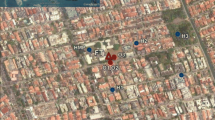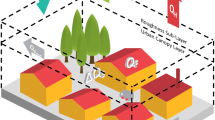Abstract
Observations of surface characteristics, meteorological conditions and energy balance components from Vancouver, B.C. are used to test the validity of the output from three one-dimensional surface energy balance models. The results show that whereas all of the models provide good simulations of net radiation, none can consistently predict the turbulent fluxes of sensible and latent heat using easily available input data. Inability to handle the role of water availability and its impact on evapotranspiration is identified as the principal problem.
Similar content being viewed by others
References
Ackerman, T. P.: 1976, ‘A Study of the Influence of Aerosols on Urban Boundary Layers with Particular Applications to the Los Angeles Basin’. Ph.D. Thesis, Univ. Washington, Seattle, 224 PP.
Ackerman, T. P.: 1977, ‘A Model of the Effect of Aerosols on Urban Climates with Particular Applications to the Los Angeles Basin’, J. Atmos. Sci. 34, 531–547.
Arnfield, A. J.: 1982, ‘An Approach to the Estimation of the Surface Radiative Properties and Radiation Budgets of Cities’, Physical Geog. 3, 97–122.
Atwater, M. A.: 1972, ‘Thermal Effects of Urbanization and Industrialization in the Boundary Layer: A Numerical Study’, Boundary-Layer Meteorol. 3, 229–245.
Bornstein, R. D.: 1986, ‘Urban Climate Models: Nature Limitations and Applications’, in T. R. Oke (ed.), Urban Climatol. and its Applic. with Spec. Regard to Trop. Areas, WMO No. 652, World Meteorol. Organiz., Geneva, pp. 237–267.
Brühl, C. and Zdunkowski, W.: 1983, ‘An Approximate Calculation Method for Parallel and Diffuse Solar Irradiances on Inclined Surfaces in the Presence of Obstructing Mountain or Buildings’, Archiv. Meteorol. Geophys. Bioclim. Ser. B, 32, 111–129.
Brutsaert, W. H.: 1982, Evaporation into the Atmosphere, D. Reidel Publ. Co., Dordrecht, Holland, 299 pp.
Businger, J. A. and Arya, S. P. S.: 1974, ‘Height of the Mixed Layer in the Stably Stratified Planetary Boundary Layer’, Advances in Geophys. 18A, 73–92.
Carlson, T. N.: 1986, ‘Regional-scale Estimates of Surface Moisture Availability and Thermal Inertia Using Remote Thermal Measurements’, Remote Sensing Reviews 1, 197–247.
Carlson, T. N. and Boland, F. E.: 1978, ‘Analysis of Urban-Rural Canopy Using a Surface Heat Flux/Temperature Model’, J. Appl. Meteorol. 17, 998–1013.
Carlson, T. N., Dodd, J. D., Benjamin, S. G., and Cooper, J. M.: 1981, ‘Satellite Estimation of the Surface Energy Balance, Moisture Availability and Thermal Inertia’, J. Appl. Meteorol. 20, 67–87.
Carson, D. J.: 1973, ‘The Development of a Dry Inversion-Capped Convectively Unstable Boundary Layer’, Quart. J. Royal Meteorol. Soc. 99, 450–467.
Cleugh, H. A. and Oke, T. R.: 1986, ‘Suburban-Rural Energy Balance Comparisons in Summer for Vancouver B.C.’, Boundary-Layer Meteorol. 36, 351–369.
Coppin, P. A.: 1979, ‘Turbulent Fluxes Over a Uniform Urban Surface’, Research Report No. 31, Instil. Atmos. Marine Sci., Flinders Univ., Adelaide, 196 pp.
Goward, S. N.: 1981, ‘Thermal Behaviour of Urban Landscapes and the Urban Heat Island’, Phys. Geog. 2, 19–33.
Greene, G. M.: 1980, ‘Testing an Urban Climate Simulator’, Geol. Survey Prof. Paper 1099-E, US Govt. Print. Office, Washington, 17 pp.
Grimmond, C. S. B., Oke, T. R., and Steyn, D. G.: 1986, ‘Urban Water Balance 1: A Model for Daily Totals’, Water Resources Res. 22, 1397–1403.
Idso, S. B.: 1981, ‘A Set of Equations for Full Spectrum and 8 to 14 Μm and 10.5 to 12.5 Μm Thermal Radiation from Cloudless Skies’, Water Resources Res. 17, 295–304.
Idso, S. B. and Jackson, R. D.: 1969, ‘Thermal Radiation from the Atmosphere’, J. Geophys. Res. 74, 5397–5403.
Kalanda, B. D., Oke, T. R., and Spittlehouse, D. L.: 1980, ‘Suburban Energy Balance Estimates for Vancouver, B.C., Using the Bowen Ratio-Energy Balance Approach’, J. Appl. Meteorol. 19, 791–802.
Kerschgens, M. J. and Hacker, J. M.: 1985, ‘The Energy Budget of the Convective Boundary Layer Over an Urban and Rural Environment’, Beitr. Phys. Atmosph. 58, 171–185.
Latimer, J. R.: 1972, ‘Radiation Measurement’, Int. Field Yr. Gt. Lakes, Tech. Manual Ser., No. 2, NRC/USNAS/IHD, Ottawa, Ont., 53 pp.
Lettau, H. H.: 1969, ‘Note on Aerodynamic Roughness-Parameter Estimation on the Basis of Roughness-Element Description’, J. Appl. Meterol. 8, 828–832.
Loudon, S.: 1984, ‘Verification of Urban Energy Balance Models’, M.Sc. Thesis, Dept. Geog., Univ. B.C., Vancouver, 145 pp.
Miller, E. L., Johnston, R. E., and Lowry, W. P.: 1972, ‘The Case of the Muddled Metromodel’, Preprints Conf. Urban Environ. Second Conf. Biometeorol. Amer. Meteorol. Soc., Boston, pp. 77–82.
Monteith, J. L.: 1961, ‘An Empirical Method for Estimating Long-Wave Radiation Exchange in the British Isles’, Quart. J. Royal Meteorol. Soc. 87, 171–179.
Myrup, L. O.: 1969, ‘A Numerical Model of the Urban Heat Island’, J. Appl. Meteorol. 8, 896–907.
Nappo, C. J. Jr.: 1972, ‘A Numerical Study of the Urban Heat Island’, Preprints Conf. Urban Environ. Second Conf. Biometeorol. Amer. Meteorol. Soc., Boston, pp. 1–47.
Nappo, C. J. Jr.: 1975, ‘Parameterization of Surface Moisture and Evaporation Rate in a Planetary Boundary Layer Model’, J. Appl. Meteorol. 14, 289–296.
Oke, T. R.: 1978, ‘Surface Heat Fluxes and the Urban Boundary Layer’, WMO Symp. Bound. Layer Physics Appl. Specific Problems Air Poll., WMO No. 510, World Meteorol. Organiz., Geneva, pp. 63–70.
Oke, T. R.: 1981, ‘Canyon Geometry and the Nocturnal Urban Heat Island: Comparison of Scale Model and Field Observations’, J. Climatol. 1, 237–254.
Oke, T. R.: 1982, ‘The Energetic Basis of the Urban Heat Island’, Quart. J. Royal Meteorol. Soc. 108, 1–24.
Oke, T. R.: 1987, Boundary Layer Climates, 2nd edn., Methuen, London, 435 pp.
Oke, T. R. and Cleugh, H. A.: 1987, ‘Urban Heat Storage Derived as Energy Balance Residuals’, Boundary-Layer Meteorol. 39, 233–245.
Oke, T. R., Kalanda, B. D., and Steyn, D. G.: 1981, ‘Parameterization of Heat Storage in Urban Areas’, Urban Ecol. 5, 45–54.
Oke, T. R. and McCaughey, J. H.: 1983, ‘Suburban-Rural Energy Balance Comparisons for Vancouver, B.C.: An Extreme Case?’, Boundary-Layer Meteorol. 26, 337–354.
Outcalt, S. I.: 1972, ‘The Development and Application of a Simple Digital Surface-Climate Simulator’, J. Appl. Meteorol. 11, 629–636.
Sellers, W. D.: 1965, Physical Climatology, Univ. Chicago Press, Chicago, 272 pp.
Sievers, U. and Zdunkowski, W. G.: 1986, ‘A Microscale Urban Climate Model’, Beitr. Phys. Atmosph. 59, 13–40.
Steyn, D. G.: 1980, ‘Turbulence Diffusion and the Daytime Mixed Layer Depth Over a Coastal City’, Ph.D. Thesis, Dept. Geog., Univ. of B.C., Vancouver, B.C., 161 pp.
Steyn, D. G.: 1985, ‘An Objective Method to Achieve Closure of Overdetermined Surface Energy Budgets’, Boundary-Layer Meteorol. 33, 303–310.
Steyn, D. G. and Oke, T. R.: 1981, ‘Effect of a Small Scrub Fire on the Surface Radiation Budget’, Weather 35, 212–215.
Steyn, D. G. and Oke, T. R.: 1982, ‘The Depth of the Daytime Mixed Layer at Two Coastal Sites: A Model and Its Validation’, Boundary-Layer Meteorol. 24, 161–180.
Stull, R. B.: 1973, ‘Inversion Rise Model Based on Penetrative Convection’, J. Atmos. Sci. 30, 1092–1099.
Suckling, P. W. and Hay, J. E.: 1976, ‘Modelling Direct, Diffuse and Total Solar Radiation for Cloudless Days’, Atmosphere 14, 298–308.
Tennekes, H.: 1973, ‘A Model for the Dynamics of the Inversion Above a Convective Boundary Layer’, J. Atmos. Sci. 30, 558–567.
Terjung, W. H. and Louie, S. S.-F.: 1974, ‘A Climatic Model of Urban Energy Budgets’, Geographical Analysis 6, 341–367.
Terjung, W. H. and O'Rourke, P. A.: 1980, ‘Simulating the Causal Elements of Urban Heat Islands’, Boundary-Layer Meteorol. 19, 93–118.
Todhunter, P. E. and Terjung, W. H.: 1988, ‘Intercomparison of Urban Climate Model Surface Energy Fluxes’, Boundary-Layer Meteorol. 42, 181–205.
Venkatram, A. and Viskanta, R.: 1977, ‘Radiative Effects of Elevated Pollutant Layers’, J. Appl. Meteorol. 16, 1256–72.
Yap, D. H., Black, T. A. and Oke, T. R.: 1974, ‘Calibration and Tests of a Yaw Sphere-Thermometer System for Sensible Heat Flux Measurements’, J. Appl. Meteorol. 13, 40–45.
Author information
Authors and Affiliations
Rights and permissions
About this article
Cite this article
Ross, S.L., Oke, T.R. Tests of three urban energy balance models. Boundary-Layer Meteorol 44, 73–96 (1988). https://doi.org/10.1007/BF00117293
Accepted:
Issue Date:
DOI: https://doi.org/10.1007/BF00117293




